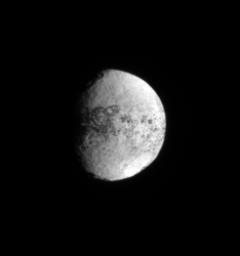Unveiling Iapetus
Caption:
As the Cassini spacecraft sets up for its September 2007 close encounter with the two-toned moon Iapetus, the spacecraft is seeing more of the moon's bright, trailing hemisphere. This is a region Cassini has seen relatively little of until recently. The September encounter will provide high resolution images of this region, including the large crater seen here at about the five o'clock position.
North on Iapetus (1,468 kilometers, or 912 miles across) is up and rotated about 5 degrees to the right.
The image was taken using a spectral filter sensitive to wavelengths of ultraviolet light centered at 338 nanometers. The view was acquired with the Cassini spacecraft narrow-angle camera on July 3, 2007. The view was acquired at a distance of approximately 2.2 million kilometers (1.4 million miles) from Iapetus and at a Sun-Iapetus-spacecraft, or phase, angle of 53 degrees. Image scale is 13 kilometers (8 miles) per pixel.
Background Info:
The Cassini-Huygens mission is a cooperative project of NASA, the European Space Agency and the Italian Space Agency. The Jet Propulsion Laboratory, a division of the California Institute of Technology in Pasadena, manages the mission for NASA's Science Mission Directorate, Washington, D.C. The Cassini orbiter and its two onboard cameras were designed, developed and assembled at JPL. The imaging operations center is based at the Space Science Institute in Boulder, Colo.
For more information about the Cassini-Huygens mission visit
http://saturn.jpl.nasa.gov/home/index.cfm
. The Cassini imaging team homepage is at
http://ciclops.org
.
Cataloging Keywords:
| Name |
Value |
Additional Values |
| Target |
Iapetus |
|
| System |
Saturn |
|
| Target Type |
Satellite |
|
| Mission |
Cassini-Huygens |
|
| Instrument Host |
Cassini Orbiter |
|
| Host Type |
Orbiter |
|
| Instrument |
Imaging Science Subsystem (ISS) |
|
| Detector |
Narrow Angle Camera |
|
| Extra Keywords |
Crater, Grayscale, Rotation, Ultraviolet, Visual |
| Acquisition Date |
|
| Release Date |
2007-08-21 |
| Date in Caption |
2007-07-03 |
|
| Image Credit |
NASA/JPL/Space Science Institute |
| Source |
photojournal.jpl.nasa.gov/catalog/PIA09010 |
| Identifier |
PIA09010 |

 Planetary Data System
Planetary Data System
